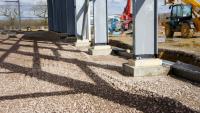 Add My Company
Add My Company
Sign In

If you’re a contractor or architect working on an industrial building, chances are steel is a key material for the build. Steel has an approximate 90% market share for single-storey industrial buildings, as its strength and versatility are big selling points, however, its thermal performance isn’t always considered. This is where structural thermal breaks come into play, as they can substantially cut energy loss, as well as saving money on a building’s running costs.
Although thermal bridging issues are now commonly recognised in steel projects, and often addressed at the design stage, awareness of the variety of projects in which they can be used and the technology behind them is more unknown. Effectively isolating temperatures can actually reduce the R value of a wall, floor or roofing assembly by as much as 60% – pretty impressive, right?!
A structural thermal break can be used in a variety of steel construction applications such as balconies and foundations. Balconies are often made from cantilevered steel or aluminum elements and are typically connected to slab edges or spandrel beams on the interior side of the thermal envelope. Installing a structural thermal break at this connection will improve the U value of a wall assembly that includes this type of point transmittance. We also undertook a column base application project for Aldi to isolate its cold store units, read more about that here.
Within a sector moving towards improving energy rating systems for new buildings, alongside better control and reduction of energy consumption, structural thermal breaking has become an important issue. As thermal bridging specialists, we are always here to help, so if you have a thermal bridging issue or would like to discuss an upcoming project please do get in touch.
For more information on Thermal breaking in structural steel projects talk to Armatherm
Enquire Now
List your company on FindTheNeedle.
